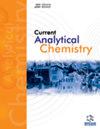Analysis of Seven Terpenoids by HS-SPME Coupled with GC-MS for the Identification and Classification of Different Teas
IF 1.7
4区 化学
Q3 CHEMISTRY, ANALYTICAL
引用次数: 0
Abstract
Background: Terpenoids are essential aroma substances in teas, and their concentration brings various characteristics to different teas. Therefore, developing a simple and stable method is necessary for distinguishing tea categories. Objective: In previous studies, more attention was paid to non-chiral isomers of terpenes due to the challenges of separating chiral isomers. So, this paper aims to present a method for effectively separating seven terpenoid substances, including chiral isomers and non-chiral isomers, to facilitate the classification and identification of teas. objective: In previous studies, more attention was paid to non-chiral isomers of terpeniods due to the challenges with separating chiral isomers. So, this paper aims to present a method for effectively separating seven terpenoid substances, including chiral isomers and non-chiral isomers, to facilitate the classification and identification of teas. Methods: A method utilizing headspace solid-phase microextraction coupled with gas chromatography- mass spectrometry was used to isolate and analyze 7 terpenoid compounds. After optimized conditions, the BGB-176 chiral column and the PDMS/DVB fiber were selected for subsequent analysis. Results: This method has a good linear range of 0.1-200 mg/L, and its linear correlation coefficients are between 0.9974 and 0.9994, and the limit of detection and the limit of quantification is 0.02–0.03 and 0.06–0.09 mg/L, respectively. Only five terpenoid substances were detected in a total of 15 tea samples. Furthermore, In the detection of carvon and α-ionone optical isomers, the S isomer was mainly detected. Conclusions: An effective approach was developed to separate and analyze 7 terpenoid compounds in natural and synthetic teas. Meanwhile, 15 tea samples can be identified and classified using principal component analysis.利用 HS-SPME 与 GC-MS 联用分析七种萜类化合物,对不同茶叶进行鉴定和分类
背景:萜类化合物是茶叶中不可或缺的香气物质,它们的浓度会给不同的茶叶带来不同的特征。因此,有必要开发一种简单而稳定的方法来区分茶叶类别。研究目的在以往的研究中,由于分离手性异构体的难题,人们更多地关注萜烯类化合物的非手性异构体。因此,本文旨在提出一种有效分离七种萜类物质(包括手性异构体和非手性异构体)的方法,以促进茶叶的分类和鉴定:在以往的研究中,由于分离手性异构体的难题,人们更多地关注萜类化合物的非手性异构体。因此,本文旨在介绍一种有效分离七种萜类物质(包括手性异构体和非手性异构体)的方法,以促进茶叶的分类和鉴定。方法:采用顶空固相微萃取-气相色谱-质谱联用方法分离分析了 7 种萜类化合物。优化条件后,选择 BGB-176 手性色谱柱和 PDMS/DVB 纤维进行后续分析。结果表明该方法的线性范围为0.1~200 mg/L,线性相关系数为0.9974~0.9994,检出限和定量限分别为0.02~0.03 mg/L和0.06~0.09 mg/L。在总共 15 份茶叶样品中,只检测到 5 种萜类物质。此外,在检测香芹酮和α-葱酮光学异构体时,主要检测到 S 异构体。结论建立了一种有效的方法来分离和分析天然茶叶和合成茶叶中的 7 种萜类化合物。同时,利用主成分分析法对 15 个茶叶样品进行了鉴定和分类。
本文章由计算机程序翻译,如有差异,请以英文原文为准。
求助全文
约1分钟内获得全文
求助全文
来源期刊

Current Analytical Chemistry
化学-分析化学
CiteScore
4.10
自引率
0.00%
发文量
90
审稿时长
9 months
期刊介绍:
Current Analytical Chemistry publishes full-length/mini reviews and original research articles on the most recent advances in analytical chemistry. All aspects of the field are represented, including analytical methodology, techniques, and instrumentation in both fundamental and applied research topics of interest to the broad readership of the journal. Current Analytical Chemistry strives to serve as an authoritative source of information in analytical chemistry and in related applications such as biochemical analysis, pharmaceutical research, quantitative biological imaging, novel sensors, and nanotechnology.
 求助内容:
求助内容: 应助结果提醒方式:
应助结果提醒方式:


